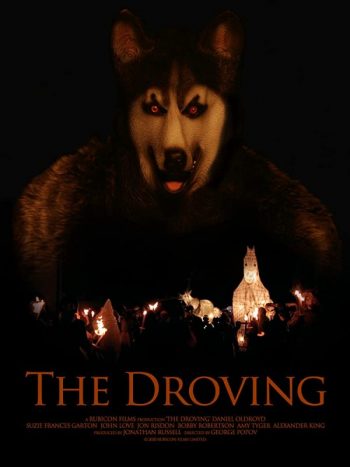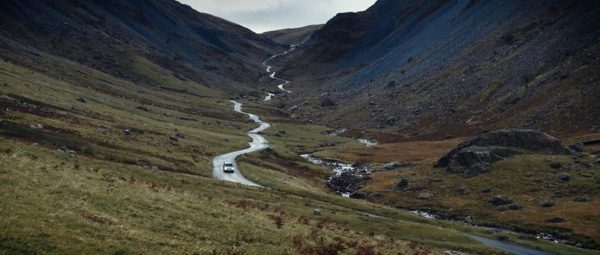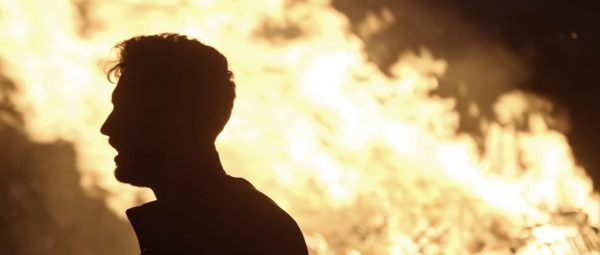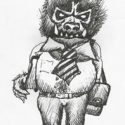The Droving (2020)
Directed by: George Popov
Written by: George Popov, Jonathan Russell
Starring: Amy Tyger, Daniel Oldroyd, Suzie Frances Garton
 The Droving
The Droving
Directed by George Popov
Almost 20 years ago, I remember watching a now mostly forgotten Scottish flick called The Last Great Wilderness: my first ever folk horror. And though bits and pieces of it didn’t work, I loved its combo of intimate storytelling, cross-dressing and landscape-porn. Shortly after, I saw one of its primary inspirations: The Wicker Man. It was the film that set the standard, plus the template, for folk horrors to follow. Here, in his sophomore outing, George Popov gives it an English twist and subverts the usual formula. Whereas we’d typically see an outsider enter a community, and find out they’re corrupt, The Droving does it the other way round by having the community corrupted by outsiders. In this case, it’s the out of towners, who come in animal attire, for the eponymous festival. Then we have Martin (Oldroyd): a former soldier, returned from serving in Bahrain, to track down his sister. She’s an almost mythic figure, described as kind, open-minded and funny among other positive adjectives, who went missing around the time of an annual festival called ‘The Droving’.
This quest takes him around ruins, up hills and into the throws of the fest itself. It’s a movie about how traditions get buried with modernisation – be them old rituals, communities or even, as this film looks at, versions of masculinity. So it is fitting that we start on a traditional folk arrangement over the opening shots of hills, rivers and lakes: a set-up that immediately aligns this movie with the type of supernatural tales wanderers may tell as they warm their hands in bothies. Now normally I barely comment on scores, unless they’re exceptional – in some ways, proof of their effectiveness is when you don’t notice them at all. Still, after this wonderfully effective opener, the music was notable in its absence – for the most part being a screaming silence. This decision doesn’t have to be a problem – I can get behind minimalism, and often have done when it is used to amplify confrontations. However, for them to work the scenes’ momentum has to do more of the heavy lifting for them to have the same impact.

Unfortunately, the dialogue, or at least its pacing, is stilted. There’s just not enough of a mental ‘game’ running through the core scenes, with characters having a thumb war of reason rather than a battle of wits. A lot of this is because the military-trained Martin rarely, if ever, seems out of his depth when tangling with people who are shorter, less healthy and/ or much older than him. Hence last confrontation, in particular, doesn’t have the dramatic tension you may expect from a finale. As he reminds us, the guy’s jumped out of planes, taken fire and gone up against religious extremists – he’s never in much danger. On this point, I expect his background of tangling with, and torturing, religious extremists is to act as a parallel for his current situation – in which he ostensibly takes on others. As an idea, this is fine – and potentially a novel means of contextualising this small-scale horror with real-world issues. Yet in characterising the people who wear masks, and believe in magic, as the exceptions then the folksy aspect does not get explored in the way it would in other offerings like Midsommar, Witchfinder General or even Kill List. It’s also further undermined when we find out the antagonist’s motivation, which is more personal than secular – not that the two ought to be considered mutually exclusive.

Getting to this solution also becomes a linear process. Martin speaks to someone, who points him to someone else, who points him to someone else etc. until he finds out what happened. Hence a lot of the most important supporting roles are limited to single transactional scenes, in which they exchange information for threats or pleasantries. There are surprisingly few recurring roles, meaning that the mystery aspect of the story is underwhelming because we don’t get to know anybody well enough to feel betrayed by them. Yeah, each one also serves the wider themes by showing how the same customs can be viewed from different angles. But from a plotting point of view, they’re there for sometimes repetitive expositional chat, before sending Martin on his way to the next source of information. There are some mild action scenes, though they are brief and their choreography with the sort of “you put your hand here” fumbling you’d expect from a martial arts class.

I don’t want to sound negative, as there’s still a lot I really liked about The Droving. For instance, the less functional conversational bits have the sort of incidental banter that makes them seem real. Then there’s Martin. Initially, he seemed like a blank slate for me – a sort of default protagonist, whom we know is undergoing a bad period in his life because he’s grown a beard since the flashback. Nonetheless, the more we learn about him, and the darker aspects of his character, then the more interesting he becomes. Popov asks us to interrogate his motives, and violent tendencies, in a way most directors telling this kind of story wouldn’t. In particular, an excellent drinking scene made me reevaluate the sort of revenge story I was seeing. It’s a shame the other parts aren’t similarly fleshed out. I also really enjoyed the atmosphere and use of locations – especially how effectively Popov captures both the grandeur and isolation of the great outdoors. Something I think will appeal to people on lockdown no matter which bit of the UK they’re from.
The Droving is on Amazon Prime


I hated this film, it was so slow and the directing was awful!! stilted is the word i would use too!!!! since then i saw small reviews from people with less than a few hundred followers, george the director is not a director justa wanna be. awful movie my wife agrees too